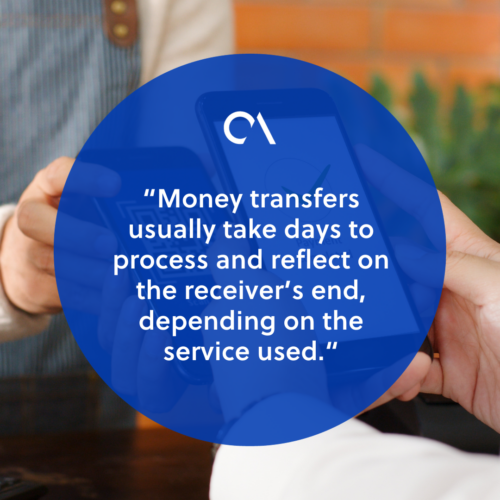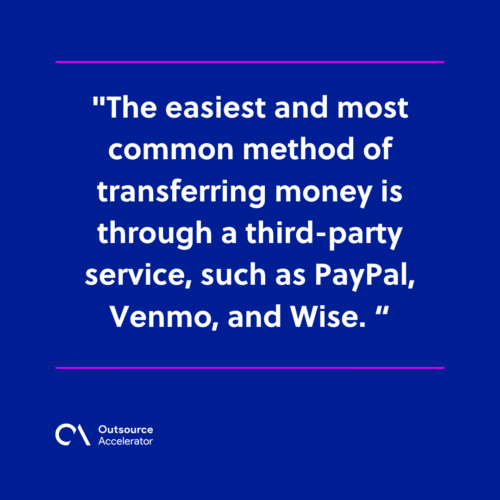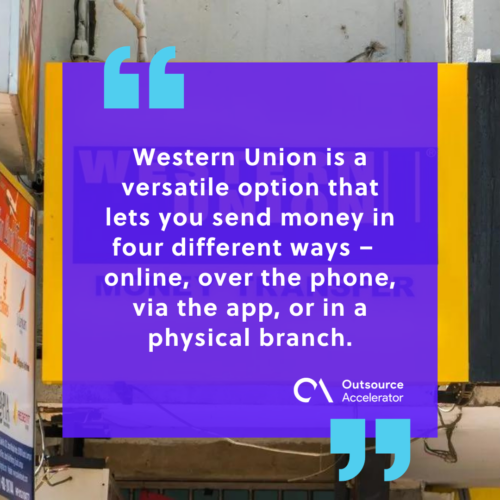A complete guide to international money transfer

As more enterprises resort to hiring talent from other countries, transferring money internationally becomes all the more important.
Businesses must consider certain things, such as exchange rates, transfer fees, and getting the money to come through on time.
Continue reading this article to learn more about how international money transfer works and which service is the best for you.
How does international money transfer work?
International money transfer is the process of sending or receiving money from one country to another.
For example, US employers with Filipino employees must pay them in Philippine pesos through a bank or money transfer app.
Money transfers usually take days to process and reflect on the receiver’s end, depending on the service used.

Steps to make an international money transfer
Transferring money internationally is a pretty straightforward process, though some methods take more time to complete than others.
Here is a breakdown of how the process works using a money transfer app:
1. Gather customer information
The first thing you need to note is the recipient’s information. This includes the name, account details, how much money you must pay them, and in what currency.
In some cases, the recipient may have to provide documentation or a form of identification before receiving the money, but this depends on the service provider’s regulations.
2. Check exchange rate and fees
The exchange rate or conversion rate is a crucial factor of transferring money internationally since every country has a different currency. These rates will fluctuate every so often.
If you are sending money to employees in the Philippines, one US dollar is equivalent to around 56 PHP. This may be higher or lower in the future.
Depending on the provider, you may have to pay conversion fees or service fees before sending the money. Consider the option that has the lowest processing fees.
3. Transfer amount
Once you have all the relevant details, you can begin your transfer. You will be asked to input the necessary information into your money transfer app.
All these details will be shared with you via email. Processing may take a few days, depending on the service provider. The money transferred will then be converted into the recipient’s currency.
Choosing the best international money transfer method
Listed below are the different methods of international money transfer you can try, each one with its own benefits:
Online money transfer
The easiest and most common method of transferring money is through a third-party service, such as PayPal, Venmo, and Wise.
The process is simple and almost immediate. All you have to do is input the recipient’s information and how much you would like to pay them into the payment service.
The fees vary depending on the service used and the amount transferred, and the money can reflect within a few hours up to a few business days.
Online wire transfer
An online wire transfer is the process of transferring money electronically through a bank-administered network.
The sender provides the payment upfront at the bank, along with the recipient’s information and the reason for the transfer.
The transaction documents are sent from the payer’s bank and received by the recipient’s bank. The whole process is officiated by systems such as SWIFT or Fedwire to ensure your money is secure and gets to its destination.
Once the recipient’s bank receives the information, it deposits the funds into the designated account. The process may take a few business days.

International money order
An international money order is a paper document bought with the amount you want to send. It is then brought to the post office and mailed to your recipient. Receivers can then exchange this document for cash once received.
This method is rather old, especially with the rise of money transfer apps. It is safer than mailing actual cash overseas as you are sending a document stating how much you are paying.
It doesn’t require a bank account to send or receive. Since it is treated as normal mail, the recipient can receive it in their mailbox.
However, this method is very slow and outdated, so the recipient will take a lot longer to receive their document. The same process applies as you must consider the different exchange rates and issuing fees.
Bank drafts
Bank drafts (in this case, foreign drafts since you are paying internationally) are a type of check whose payment is guaranteed by the bank.
If an employer from the United States wants to pay a Filipino employee working from abroad, the employer must go to the bank and issue a bank draft for a certain amount. That amount is set aside in a temporary hold until it is cashed out by the payee overseas.
The employer then sends this bank draft to the Philippines with the amount already converted to Philippine currency.
Once received, the employee presents the bank draft to a local bank and cashes out the same amount the employer set aside.
A bank draft is a safe and efficient way for money to be kept safe by the bank and prevents bounce checks. It ensures the payee receives the due amount since it was already set aside.
This type of money transfer is usually done for larger payments, such as for a car or house, but can be used for smaller purposes.
Best international money transfer services
There is a wide range of money-transferring apps you can choose from, each with varying transfer fees and processing times.
Check out the options listed below to determine which is the best service for you:
PayPal
PayPal is a long-established money transfer platform that makes sending and receiving money incredibly easy.
It can be used for small transactions and can be done using only the recipient’s email address. Creating a PayPal account is free and is usable in 200 countries, including the Philippines.
However, one disadvantage of PayPal is its high fees, which could go up to 4.5%. If you do not want to pay high extra amounts, you can choose a PayPal alternative instead.
Wise
Wise is a great option for small, speedy transactions with low charges. It can facilitate up to 70 countries and offers competitive exchange rates.
You have different payment options, such as wire transfers or credit and debit card transfers. One convenient feature is that your recipient doesn’t need a Wise account to receive the money.
Western Union
Western Union is a versatile option that lets you send money in four different ways – online, over the phone, via the app, or in a physical branch.
This service allows you to coordinate a cash pickup, which is convenient if your recipient does not have a bank account. The cash can be dropped off at a Western Union branch and be picked up there.
The downside is its fees are quite expensive and are not fixed, depending on the country and external factors.

MoneyGram
MoneyGram is a solid choice with over 300,000 worldwide locations and low transfer fees, perfect for fast transactions and emergency situations.
The app is intuitive, and transfers are done within the same day. It allows you to send money to users who do not have a bank account. However, it has a high rate markup of 3% or more and a limit of $10,000 per online transfer.
OFX
OFX is ideal for large transfers as it has no maximum amount and no fees. It has a minimum spend of $1000 and can be sent directly from the app or website.
It does not allow credit card or cash transactions, so it is limited to bank account transfers.
However, it is advantageous as bank accounts are a safe and low-risk payment method. A disadvantage is that the process is a lot slower than other services.
WorldRemit
WorldRemit is an affordable option with low fees, ranging from 1-1.5%. It offers instant transactions and can be used with debit cards or bank accounts. The money is immediately converted into the recipient’s currency.
This service is not ideal for business exchanges as it has a limit of $5,000 per transaction. Instead, it is best used for quick, peer-to-peer transfers.
Making international money transfer easier
International money transfer is an integral part of enterprises that manage overseas Filipino workers. It allows employers to pay their foreign workers quickly and efficiently.
Apart from salaries, it lets businesses manage operations and teams based abroad and supply them with the necessary funds to complete their business objectives.
However, challenges, such as high processing fees, fluctuating conversion rates, and slow transfer times, are unavoidable.
Business leaders must navigate these drawbacks and determine the best, most risk-free way to ensure their employees receive their payment.







 Independent
Independent




